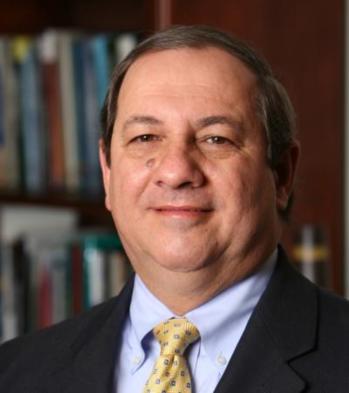Lopez Delivers 2018 Hesburgh Lecture on Peacebuilding
By Mary Frasier, Staff Writer
On Thursday evening, April 12, in Mara Auditorium the Gettysburg Notre Dame Club held its 2018 Hesburgh Alumni Lecture. The event was co-sponsored by the Economics, Africana Studies, Globalization Studies, and the Center for Religious and Spiritual Life on campus. This year’s featured speaker was Dr. George Lopez, who holds the Rev. Theodore M. Hesburgh, C.S.C., Chair in Peace Studies at the Kroc Institute for International Peace Studies at the University of Notre Dame and the position of Professor Emeritus. He became the Vice President of the Academy for International Conflict Management and Peacebuilding at United States Institute of Peace, Washington DC in September 2013. Dr. Lopez received his Ph. D in International Relations from Syracuse University.
Lopez presented his discussion “The New Peacebuilding: Challenges and Opportunities,” speaking about the diverse needs of the international peacebuilding community in the 21st century. He began the discussion by touching on local violence and how the audience members could help contribute to peacebuilding on their own communities. However, Lopez quickly moved on to international peacebuilding information, since his specialty is international relations. From the research done, Lopez relayed to the audience that the cycle of violence at the local and global level is converging, so much like politics, violence is up close and personal and now calls for peacebuilding on the local, community level. However, the global list of communities experiencing violent conflict continues to grow which causes the list of needs to increase.
During his discussion, Lopez talked in depth about a graph that he and colleague had created a few years ago. He calls it the “Life Cycle of a Conflict and Institute of Peace Activities.” The bell curve begins with Routine Diplomacy and ends with Post-Conflict Peacebuilding, with many options and possibilities falling in between, such as Crisis Diplomacy or the outbreak of violence. He continued to explain the various scenarios of international conflict and how each story was applicable to different section on the bell curve.
Lopez emphasized the much-needed shift from Conflict Resolution to Conflict Transformation in today’s society. During Conflict Resolution, the negotiation among parties is equal and it aims to solve one problem or only a few single problems through compromise. This is to relieve the issues in the short term. Conflict Transformation builds a dialogue among unequal parties to try to build a relationship because compromise can be too limited. This is the best strategy for peace because it is a slow, long-term process used to create a shared future.
A major part of his lecture, however, is how we can all work on building peace in today’s violent world. A disheartening statistic the professor emeritus shared with the audience was that only about half of peace agreements last beyond five years, which emphasizes the need to research what makes certain peace hold and not others. Lopez had many suggestions, including to think, plan, and act more strategically and to make sure there are insiders and outsiders working in interconnected nations throughout the world. Within strategic peacebuilding, Lopez explained the use of the SAT model, which stands for Structural changes, Attitudinal changes, and Transactional changes. These methods are something the international community uses but can also be tweaked to be used at the local level to help prevent local violence. He encouraged the audience to take action in their local communities and use the tools he presented them with to improve the amount of violence they experience.
“We need police that don’t beat and intimidate people, before they ask them what they are doing,” he exclaimed, referencing local violence that has recently been seen in the news.
Lopez concluded the lecture by explaining that peaceworkers and peacebuilders are not only expert professionals with a master’s degree in peace studies, but professionals in related fields are using their prior knowledge from other subject areas to help contribute to the peacebuilding. He finished by reiterating to the audience that they do not need a degree to promote and build peace in the world, especially now that he has given them the tools to build peace.

